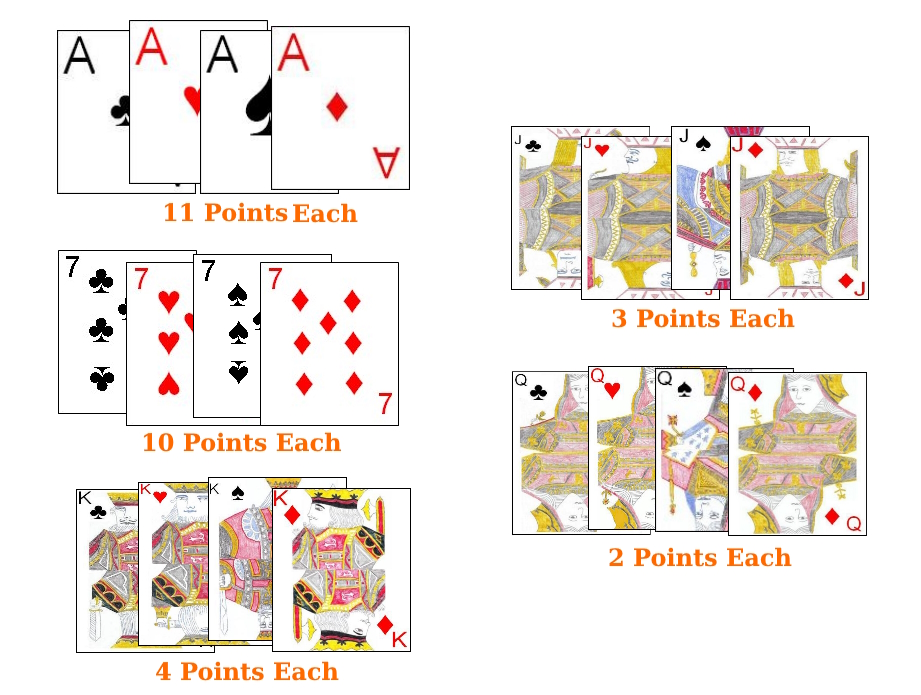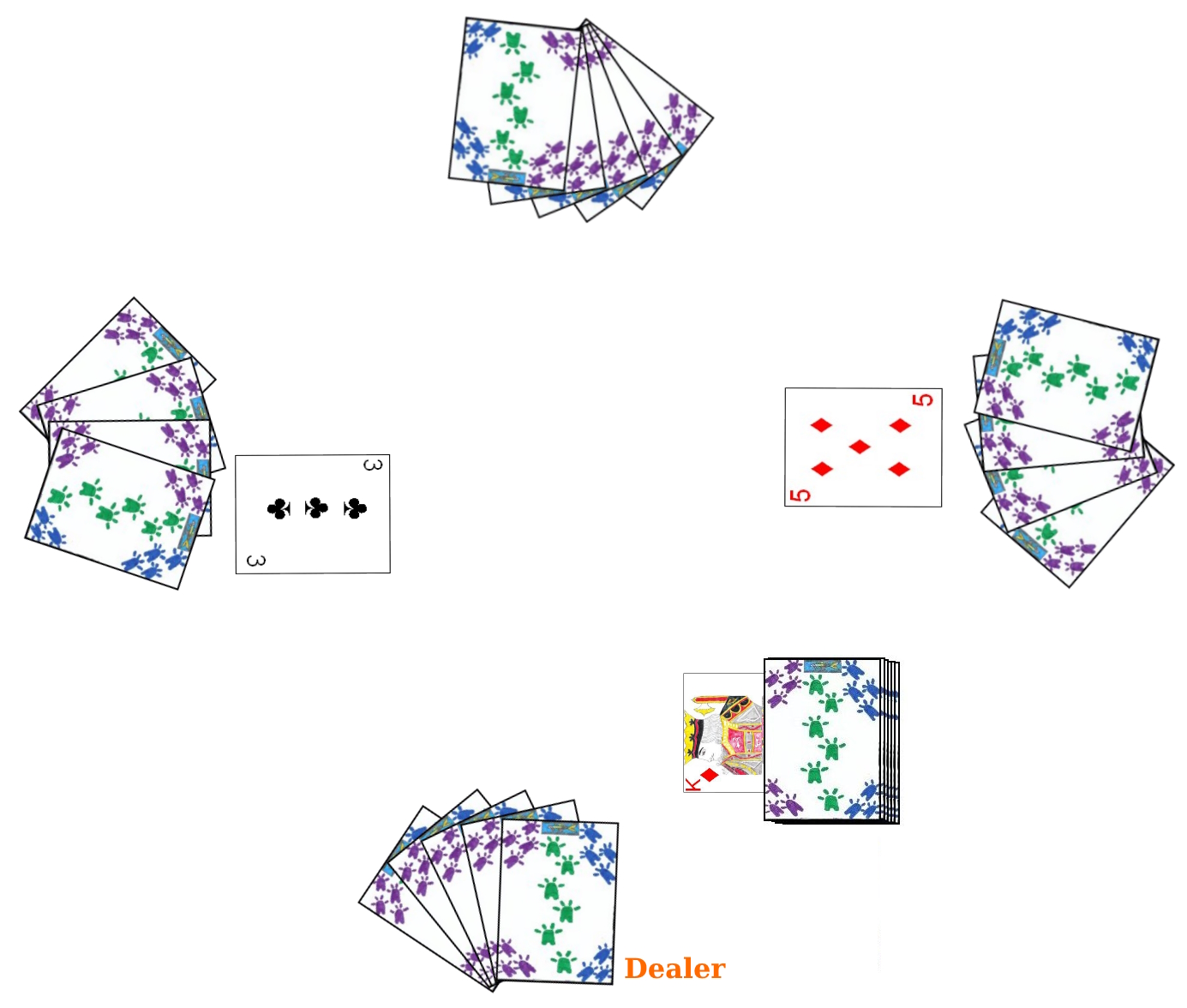Two Player Albastini: Albastini can also be played by two participants. Obviously, there are no partners in the two player version, with each player playing for himself. In addition, the following changes are the only differences in the two player variant:
- Only the opponent of the dealer will make a bid, placing one card from his hand face-up on the table. This bid is optional.
- If both players eat exactly 60 total points during the game, the game is a tie.
- The winner of each game will score one Victory Point if his opponent has "eaten" at least 10 points. If his opponent has "eaten" fewer than 10 such points, he scores 2 Victory Points instead.
Other than these few differences, the two player variant is played identically to the four player version as described above.
Three Player Albastini: Albastini can (and often is) played by three individual players. The following are the differences of the three player version than the four player version as described previously:
- Each player plays and scores independently, with no partnerships.
- Both opponents of the dealer are entitled, if they prefer, to make a bid of the trump suit, starting with the player at the dealer's left and continuing to the next opponent. As normal, if one of these players manages to correctly guess the trump suit he must exchange his bid card with the exposed trump suit card.
- If two or more players tie for the highest score in the game, the game ends in a tie, with no Victory Points awarded for that game.
- The winning player of each game normally earns one Victory Point, providing that each opponent scores 10 or more points. However, if one or both opponents score fewer than 10 total points, the winner of the game instead scores 2 Victory Points.
In all other aspects, the three player variant is played exactly the same as the four player variant described at the top of this page.
Five Player Albastini: Albastini is also available as a five player card game. Again, this five player version is played very similarly to the four player version, with the following exceptions:
- Each player plays and scores as an individual, with no partnerships.
- There is no bidding or guessing at the trump suit in the five player variant. The dealer simply sets the trump indicator card partially under the remaining, undealt stock. However, this last card is never drawn, and will simply remain on the table throughout the game and will not be drawn by any player, and will not contribute to the score of any player at the end of the hand.
- If two or more players tie for the highest number of points eaten during the game, the game is a tie, with no player earning any Victory Points.
- The winning player earns one Victory Point, as long as each other player has
eaten 10 or more total points during that game. However, if any of the opponents scores fewer than 10 total points, the winner of the game scores 2 Victory Points.
Beyond these differences, the five player version is played the same as the four player game.
 Six Player Albastini
Six Player Albastini: Albastini is sometimes played by as many as six
players. This version is always played as a partnership version.
However, the game is either played using three teams consisting of two players each, or two teams consisting of three players each. The following outlines the differences of this game from the standard four player variant described above:
- In the version consisting of two teams of three players, each player should be sitting directly between members of the opposing team. In the three team method, each player should have members of different partnerships on each side.
- All players, which are members of teams other than the dealer's team, are entitled, if they prefer, to make a bid or guess at the trump suit. The bidding starts with the player at the dealer's left and continuing around the table in a clockwise direction for each player that is not a member of the dealer's team. As normal, each bid must be of a suit not bid by a previous player during this bidding, and if one of these players manages to correctly guess the trump suit he must exchange his bid card with the exposed trump suit card.
- If two or more players tie for the most number of points eaten during a game, the game is a tie, and no Victory Points are awarded for that game.
- If playing in three partnerships of two players each, the winning team scores one Victory Point providing both of the opposing partnerships managed to eat at least 20 total points during that game. However, if one or both of the opposing partnerships eat less than 20, the winning partnership scores 2 Victory Points instead.
- If playing in two partnerships consisting of three players each, the winning team scores one Victory Point if the opposing partnership scores 30 or more points. However, if the opponents of the winners score fewer than 30 points, the winning team scores two Victory Points.
In all other aspects, the six player variations of Albastini is played identically to the four player variant.
Copyright © 2015 CatsAtCards.com. All rights reserved.

 It is customary for the player who is hosting the game to be set as the first dealer. Thereafter, a player from the winning team will be set as the dealer for the next game. As this is a partnership game, determination of partnerships can be performed using a variety of methods, with draw for high cards commonly used. In that method, each player would draw a card from the shuffled deck, and the players drawing the two highest cards would play as partners, opposed by the players drawing the two lowest cards. Each player should sit at the table directly across from his partner.
It is customary for the player who is hosting the game to be set as the first dealer. Thereafter, a player from the winning team will be set as the dealer for the next game. As this is a partnership game, determination of partnerships can be performed using a variety of methods, with draw for high cards commonly used. In that method, each player would draw a card from the shuffled deck, and the players drawing the two highest cards would play as partners, opposed by the players drawing the two lowest cards. Each player should sit at the table directly across from his partner.

 Six Player Albastini: Albastini is sometimes played by as many as six
players. This version is always played as a partnership version.
However, the game is either played using three teams consisting of two players each, or two teams consisting of three players each. The following outlines the differences of this game from the standard four player variant described above:
Six Player Albastini: Albastini is sometimes played by as many as six
players. This version is always played as a partnership version.
However, the game is either played using three teams consisting of two players each, or two teams consisting of three players each. The following outlines the differences of this game from the standard four player variant described above: